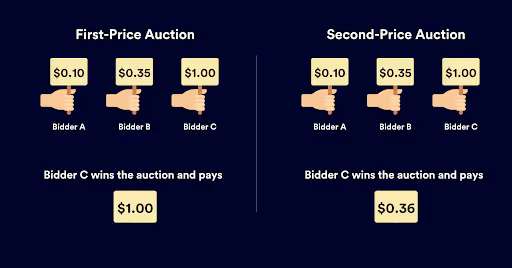
How does a generalized second price auction work?
The second-price auction is an auction model that makes it easy and safe for advertisers to bid. Instead of paying the maximum amount for an ad space (as they would in a first-price auction), advertisers pay bids higher than the next highest bid to win the auction. This gives advertisers the confidence to submit their best bids without risking overpaying for a space.
In other words, in second price auctions, advertisers bid as much money as they feel is necessary to win the auction and they are guaranteed to never overpay. Essentially, there's less risk for the advertiser.
With second-price auctions, the final price paid by the highest bidder isn't the top price. Instead, they pay slightly higher than the second price. Let's walk through an auction with the following bids to better understand how second price auctions work.
Bidder A: $0.10
Bidder B: $0.35
Bidder C: $1.00
In a first-price auction, Bidder C would win the auction (obviously) and pay $1.00 even though the next highest bid was way lower. In a second-price auction, Bidder C would win the auction and only pay $0.36 per click, slightly higher than $0.35 instead of €1.00

Even though there are advanced models that include other factors like relevance, ad quality, historical performance, etc. to calculate the bid that enters the auction, the model basically works the same way: the winning bidder always pays slightly higher than the next highest bidder.
Quality second-price auction models used by Google Ads, Amazon Ads, and Walmart Connect also factor in relevancy in addition to bid amounts. When “laundry detergent" is searched for, relevant products like "Tide" are more likely to win the auction and be displayed rather than Bounce® dryer sheets that were bid on the same term. Even if the dryer sheet brand had the highest bid, the more relevant products will win the auction.
What are the benefits of generalized second-price auctions?
1. Easy and safe for advertisers to bid
Advertisers can decide how much they value each click (for instance, they can take their conversion rate into consideration by looking at what fraction of the clicks results in a purchase and multiplying that by the profit they make from each sale), and simply bid their value. Because the price the winner pays is generally lower than their bid (and often substantially so), this strategy ensures that overall their campaigns will be profitable.
2. Overall outcomes of auctions are efficient
Bidders with the highest overall values (taking into account both how much they value each click, and how many clicks they expect to receive) will be shown in the most prominent slots on the page, while bidders with lower overall values will not be displayed as prominently - but will still receive some eyeballs and clicks. And, all bidders pay less than they initially bid.
3. Ad auctions uncover the true value of your inventory
Second-price auction models have sufficient flexibility to adjust to changing market conditions, and most importantly, adjust to reveal the true market value of your ad space, which may be much higher than you think.
4. Pricing ad space is automated and simplified for advertisers
GSP auctions automate the process of pricing ad slots for advertisers. Each advertiser is comfortable with their bid because they know that they will only be charged an amount necessary to achieve their ranking.
When each advertiser behaves in this way, each advertising slot is fairly priced. When a lot of advertisers with high values compete for the slots, prices will be higher. When the number of advertisers is smaller or their values are lower, prices will be lower. But in all cases, these prices will accurately reflect the underlying market conditions.
Want to learn more about the generalized second-price auctions? Read this paper by Topsort Cofounder and Chief Scientist Michael Ostrovsky.


